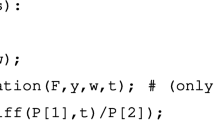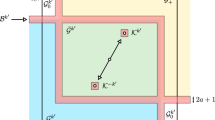Abstract
The exact relation between a Cooper-like reducibility concept and the reducibilities introduced by Hundsdorfer, Spijker and by Dahlquist and Jeltsch is given. A shifted Runge–Kutta scheme and a transplanted differential equation is introduced in such a fashion that the input/output relation remains unchanged under these transformations. This gives a technique to prove stability and contractivity results. This is demonstrated on the example of contractivity disks.
Similar content being viewed by others
References
K. Burrage and J. C. Butcher, Stability criteria for implicit Runge–Kutta methods, SIAM J. Numer. Anal., 16 (1979), pp. 46–57.
K. Burrage and J. C. Butcher, Nonlinear stability of a general class of differential equation methods, BIT, 20 (1980), pp. 185–203.
G. J. Cooper, A generalization of algebraic stability for Runge–Kutta methods, IMA J. Numer. Anal., 4 (1984), pp. 427–440.
G. J. Cooper, Reducible Runge–Kutta methods, BIT, 25 (1985), pp. 675–680.
M. Crouzeix, Sur la B-stabilitée des méthodes de Runge-Kutta, Numer. Math., 32 (1979), pp. 75–82.
G. Dahlquist and R. Jeltsch, Generalized disks of contractivity for explicit and implicit Runge–Kutta methods, Dept. of Numerical Analysis and Computing Science, The Royal Institute of Technology, Stockholm, Report TRITA-NA-7906, 1979.
G. Dahlquist and R. Jeltsch, Shifted Runge–Kutta methods and transplanted differential equations, in Numerical Treatment of Differential Equations, K. Strehmel, ed., Proceedings of the fourth Seminar held in Halle, 1987, Teubner, Leipzig, 1988.
K. Dekker and J. G. Verwer, Stability of Runge–Kutta Methods for Stiff Nonlinear Differential Equations, North-Holland, Amsterdam, 1984.
W. Gröbner, Matrizenrechnung, B.I. Hochschultaschenbücher, 103/103a, Bibliograpisches Institut, Mannheim, 1966.
M. Huang, On the contractivity region of Runge–Kutta methods, Dept. of Numerical Analysis and Computing Science, The Royal Institute of Technology, Stockholm, Report TRITA-NA-8106, 1981.
W. H. Hundsdorfer and M. N. Spijker, A note on B-stability of Runge–Kutta methods, Numer. Math., 36 (1981), pp. 319–333.
P. Lancaster, Theory of Matrices, Academic Press, New York, London, 1969.
J. Oliver, A curiosity of low-order explicit Runge–Kutta methods, Math. Comput., 29 (1975), pp. 1032–1036.
M. N. Spijker, Monotonicity and boundedness in implicit Runge–Kutta methods, Numer. Math., 50 (1986), pp. 97–109.
H. J. Stetter, Analysis of Discretization Methods for Ordinary Differential Equations, Springer, Berlin, Heidelberg, New York, 1973.
Author information
Authors and Affiliations
Corresponding author
Additional information
AMS subject classification (2000)
65L07
Rights and permissions
About this article
Cite this article
Jeltsch, R. Reducibility and contractivity of Runge–Kutta methods revisited . Bit Numer Math 46, 567–587 (2006). https://doi.org/10.1007/s10543-006-0079-7
Received:
Accepted:
Published:
Issue Date:
DOI: https://doi.org/10.1007/s10543-006-0079-7




